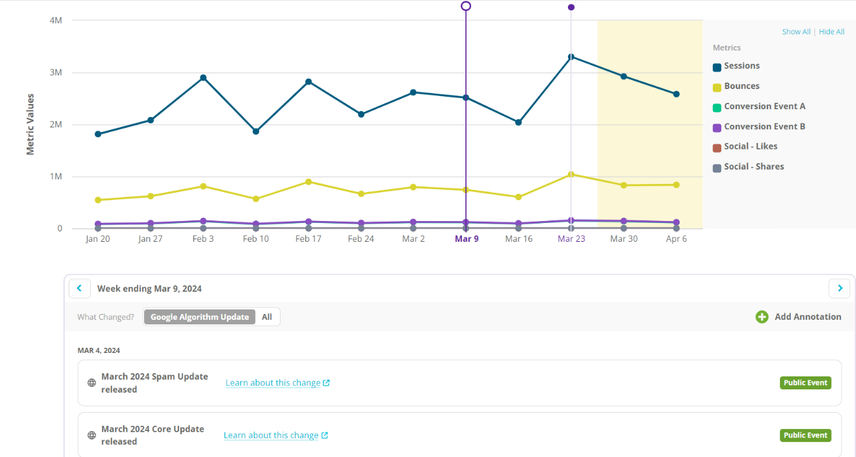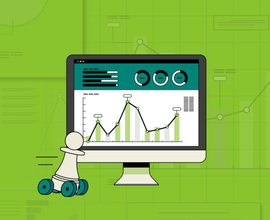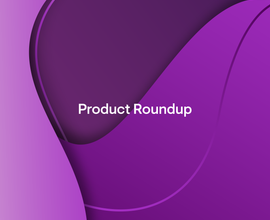March 2024 SEO Industry Updates
- Industry News
- By multiple authors
- 9 minutes read
Conductor’s coverage of the latest industry updates from the world of search. Get details about the March 2024 core and spam updates and more from Google.
Google rolls out their first major search updates of 2024
By Caroline Wilson
- Google released the first core update of 2024 on March 5th, 2024.
- Google released the first spam update of the year on March 5th. The spam update finished rolling out on March 20th.
What to know
After a quiet start to the year, Google made waves on March 5th by announcing its March 2024 core update and new spam policies . These updates are intended to enhance users' experience on Google search. Google stated, “The March 2024 core update is a more complex update than our usual core updates, involving changes to multiple core systems. It also marks an evolution in how we identify the helpfulness of content”.
In addition to this being the first algorithm update of 2024, Google has stated this update is more complex than previous core updates due to changes being made to multiple core systems and evolving how the helpfulness of content is identified. The hope is that the quality of Search improves by showing less content that appears to have been created to attract clicks and increasing the visibility of content people find useful. Compared to previous updates, which are often predicted to take less than a month, Google shared this rollout may take up to a month to complete. Running alongside the Core update, the Google March 2024 spam update took 15 days to complete. This update, which finished rolling out on March 20th, introduced new spam policies. This update targeted AI-generated spam content, the misuse of expired domains to gain rank authority, & other forms of spam abuse, to prioritize high-quality user-first information.
Why this is important
We’ve seen many SEO industry experts and commentators lament the rise of spammy and unhelpful content throughout the SERPs over the past year. It appears Google understands some of the current problems and is trying to improve the search experience by strengthening its spam policies and incorporating its helpful content system into its core ranking system.
This means that those impacted by the helpful content updates won't have to wait anymore until the next helpful content update. Instead, these are now baked into the core algo systems. Scaled content abuse, reputation abuse, and expired domain abuse are three distinct issues Google specifically calls out in their announcement. For people wondering if this was all talk, Google showed its willingness to take action as demonstrated through a flurry of manual search rankings penalties that were distributed the day after the announcement of the core update.
Based on Google’s evaluations, they expect , “that the combination of this update and our previous efforts will collectively reduce low-quality, unoriginal content in search results by 40%.”
Google updates change how Google’s algorithm evaluates and ranks content. As with many of their major updates, a consistent theme we see from Google is their advice that there is nothing different or special content creators need to do to satisfy updated policies. As long as you’re creating quality content that is meant for people, you should not have to worry about these algorithm changes, however, we know that there are often unexpected casualties from major updates.
Navigating the March 2024 core update
For everyone
As you look to prepare for increased volatility and shifts in organic performance, it’s a great idea to review Google’s Helpful content and Google Search results FAQ page , as well as their documentation on Creating helpful, reliable, people-first content . Search Engine Roundtable regularly provides updates on the progress of updates and observations from folks within the industry.
While there is likely not much meaningful immediate action you can take to change how this core update will impact your site, It’s important to have a well-rounded understanding of your organic performance and keyword rankings before the announcement of the updates to accurately measure its impact following the conclusion of the updates.
Search Engine Roundtable regularly publishes updates about core updates and often shares a variety of sources that can help you understand SERP volatility around your specific industry. While it may feel counterproductive to wait until the update is over before taking action and making changes to your content, Conductor’s guide for responding to algorithm updates recommends allowing updates to finish before taking action.
For Conductor customers
We've recently introduced public annotations on our platform, automatically indicating when an algorithm update started rolling out and when it concluded. Review your public event annotations included in the Pages section of the platform to see when these updates are completed. Once the updates have finished rolling out, consider building a workspace that can serve as your north star for measuring how this core update may have impacted your website’s organic performance.
A great way to start your workspace is by adding a widget that contains an overview of your content’s organic performance. It’s a good idea to set the “report on filter” to a fixed start date set for at least two weeks before the announcement of the update.

You can also add widgets to your workspace that display pages on your site that have experienced the greatest increases and decreases in the metrics you care the most about. Whether it’s sessions, visits, impressions, or clicks, you’ll want to understand which URLs on your site experienced the most significant swings in performance.
Measure your ranked keyword performance by adding the visibility distribution view from the Keywords section of the platform, as well as some views of your keyword ranks with filters applied for tracked searches that have moved into the top 10, fallen from the top 10, and moved into striking distance.
Adding widgets from the Page Groups and Keyword Groups section is helpful for understanding if there are any themes in the types of pages or keywords on your site that are experiencing swings in performance following an update.
- Review your keyword groups with the greatest decline in average rank over the update period. Then, use the Market Share section of the platform to investigate the specific market share of that keyword group to see which competitors have intruded into your market share.
- Include a few widgets from the domain overview in Explorer to ensure you’re taking into account tracked and untracked keyword performance for your website.
Google unleashes search ranking penalties through manual actions
By Lauren Phillips
The what
Google began penalizing sites that it felt violated spam policies, which were part of the March 2024 spam and Core update. These penalties resulted in some sites being completely or partially de-listed from the SERP and affected their traffic. If your site receives a manual penalty, follow the steps provided by Google to fix any violations.
The why
Based on evidence that Search Engine Roundtable published , the volume of sites affected by this update could reach historic levels for manual penalties in such a short amount of time. Organizations should monitor for any major traffic drops through the remainder of the latest Core Update, review their content, and ensure it follows EEAT.
For everyone
If your site is affected by a manual action, you’ll receive a notification in the manual actions report and the Search Console message center. Manual actions against a site will appear at the top of the report, but if your site doesn’t have any manual actions, you’ll see a green check mark and a notification.
For Conductor customers
Review your current organic performance since the start of the year, as well as year-over-year performance to see if you see any steep declines that are the result of getting served a manual penalty. You can reference your Search Console Analytics section to measure if you experienced any recent unexpected dips for clicks, impressions, CTR, and average rank position.
Google now says core web vitals used in ranking systems
By Kerri Kirkhuff
What to know
Google updated their documentation to acknowledge that CWV is used in their ranking systems but stops short of saying if they're ranking factors. Many SEOs and developers are concerned with their Core Web Vitals and aim to have a cleaned-up site on the backend in hopes that it will increase in ranking. For years skeptics went back and forth if CWV is a ranking factor to begin with in the first place.
Why this matters
Many SEOs and developers are concerned with their Core Web Vitals and aim to have a cleaned-up site on the backend in hopes that it will increase in ranking. For years skeptics went back and forth if CWV is a ranking factor to begin with in the first place. Google’s Updated documentation provides more clarity on the value of strong core web vitals scores for pages on your website.
For everyone
Google’s core ranking systems look to reward websites with content that provides a good experience for users. If you're unfamiliar with Google’s latest updates to its documentation about page experience, you should review their latest updates and reassess your content and page experience. Google’s updated documentation contains additional resources to help you measure, monitor, and optimize your site’s experience.
For Conductor customers
Conductor’s Chrome extension contains a technical SEO section that enables users to investigate the technical health and performance of any page through an integration with Google’s Page Speed Insights API . You can easily reference the page speed metric for any URL to determine how quickly the page loads on mobile and desktop.
ContentKing users can track web vitals metrics for every page on their site. This feature enables you to easily focus on parts of your website where the web vitals scores are low or require improvements. Thanks to ContentKing’s intelligent prioritization methods, you’ll have a clear understanding of which issues you should resolve first to impact the overall health of your website.
Stay tuned
For more coverage of Google’s updates as well as additional recommendations from the folks over at Conductor, check back on the blog for more content and consider tuning into one of our upcoming virtual events. Stay on top of the latest in the world of search by tuning into our 30 | 30 series to watch our VP of Services & Thought Leadership, Pat Reinhart, as he breaks down updates in search, Google's algorithm, technical SEO, and content marketing in the last 30 days – in just 30 minutes.









